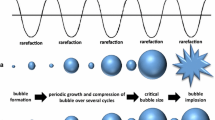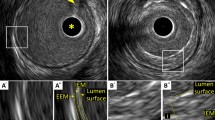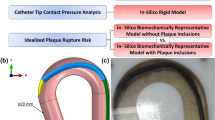Abstract
Objectives
Thrombosis is a leading cause of failure for cardiovascular devices. While computational simulations are a powerful tool to predict thrombosis and evaluate the risk for medical devices, limited experimental data are available to validate the simulations. The aim of the current study is to provide experimental data of a growing thrombus for device-induced thrombosis.
Materials and methods
Thrombosis within a backward-facing step (BFS), or sudden expansion was investigated, using bovine and human blood circulated through the BFS model for 30 min, with a constant inflow rate of 0.76 L/min. Real-time three-dimensional flow-compensated magnetic resonance imaging (MRI), supported with Magnevist, a contrast agent improving thrombus delineation, was applied to quantify thrombus deposition and growth within the model.
Results
The study showed that the BFS model induced a flow recirculation region, which facilitated thrombosis. By 30 min, in comparison to bovine blood, human blood resulted in smaller thrombus formation, in terms of the length (13.3 ± 0.6 vs. 18.1 ± 1.3 mm), height (2.3 ± 0.1 vs. 2.6 ± 0.04 mm), surface area exposed to blood (0.67 ± 0.03 vs 1.05 ± 0.08 cm2), and volume (0.069 ± 0.004 vs. 0.093 ± 0.007 cm3), with p < 0.01. Normalization of the thrombus measurements, which excluded the flow recirculation effects, suggested that the thrombus sizes increased during the first 15 min and stabilized after 20 min. Blood properties, including viscosity, hematocrit, and platelet count affected thrombosis.
Conclusion
For the first time, contrast agent-supported real-time MRI was performed to investigate thrombus deposition and growth within a sudden expansion. This study provides experimental data for device-induced thrombosis, which is valuable for validation of computational thrombosis simulations.





Side and top views of the thrombi reconstructed in current study and Taylor et al. [20] are shown for comparison

The error bars represent SEM with N = 6 for the current study and N = 3 for Taylor et al. [20]
Similar content being viewed by others
References
Benjamin EJ, Blaha MJ, Chiuve SE, Cushman M, Das SR, Deo R, De Ferranti SD, Floyd J, Fornage M, Gillespie C, Isasi CR, Jim’nez MC, Jordan LC, Judd SE, Lackland D, Lichtman JH, Lisabeth L, Liu S, Longenecker CT, MacKey RH, Matsushita K, Mozaffarian D, Mussolino ME, Nasir K, Neumar RW, Palaniappan L, Pandey DK, Thiagarajan RR, Reeves MJ, Ritchey M, Rodriguez CJ, Roth GA, Rosamond WD, Sasson C, Towfghi A, Tsao CW, Turner MB, Virani SS, Voeks JH, Willey JZ, Wilkins JT, Wu JHY, Alger HM, Wong SS, Muntner P (2017) Heart disease and stroke statistics—2017 update: a report from the American Heart Association. Circulation 135:e146–e603
Kirklin JK, Naftel DC, Kormos RL, Pagani FD, Myers SL, Stevenson LW, Acker MA, Goldstein DL, Silvestry SC, Milano CA, Baldwin JT, Pinney S, Rame JE, Miller MA (2014) Interagency Registry for Mechanically Assisted Circulatory Support (INTERMACS) analysis of pump thrombosis in the HeartMate II left ventricular assist device. J Hear Lung Transplant 33:12–22
Dürrleman N, Pellerin M, Bouchard D, Hébert Y, Cartier R, Perrault LP, Basmadjian A, Carrier M (2004) Prosthetic valve thrombosis: twenty-year experience at the Montreal Heart Institute. J Thorac Cardiovasc Surg 127:1388–1392
Nobili M, Sheriff J, Morbiducci U, Redaelli A, Bluestein D (2008) Platelet activation due to hemodynamic shear stresses: damage accumulation model and comparison to in vitro measurements. ASAIO J 54:64–72
Navitsky MA, Deutsch S, Manning KB (2013) A thrombus susceptibility comparison of two pulsatile Penn state 50 cc left ventricular assist device designs. Ann Biomed Eng 41:4–16
Vogler EA, Siedlecki CA (2009) Contact activation of blood-plasma coagulation. Biomaterials 30:1857–1869
Chesnutt JKW, Han HC (2016) Computational simulation of platelet interactions in the initiation of stent thrombosis due to stent malapposition. Phys Biol 13:016001
Ou C, Huang W, Yuen MMF (2017) A computational model based on fibrin accumulation for the prediction of stasis thrombosis following flow-diverting treatment in cerebral aneurysms. Med Biol Eng Comput 55:89–99
Topper SR, Navitsky MA, Medvitz RB, Paterson EG, Siedlecki CA, Slattery MJ, Deutsch S, Rosenberg G, Manning KB (2014) The use of fluid mechanics to predict regions of microscopic thrombus formation in pulsatile VADs. Cardiovasc Eng Technol 5:54–69
Chivukula VK, Beckman JA, Prisco AR, Dardas T, Lin S, Smith JW, Mokadam NA, Aliseda A, Mahr C (2018) Left ventricular assist device inflow cannula angle and thrombosis risk. Circ Heart Fail. https://doi.org/10.1161/CIRCHEARTFAILURE.117.004325
Taylor JO, Meyer RS, Deutsch S, Manning KB (2016) Development of a computational model for macroscopic predictions of device-induced thrombosis. Biomech Model Mechanobiol 15:1713–1731
Taylor JO, Yang L, Deutsch S, Manning KB (2017) Development of a platelet adhesion transport equation for a computational thrombosis model. J Biomech 50:114–120
Fogelson AL, Guy RD (2008) Immersed-boundary-type models of intravascular platelet aggregation. Comput Methods Appl Mech Eng 197:2087–2104
Menichini C, Xu XY (2016) Mathematical modeling of thrombus formation in idealized models of aortic dissection: initial findings and potential applications. J Math Biol 73:1205–1226
Wu WT, Jamiolkowski MA, Wagner WR, Aubry N, Massoudi M, Antaki JF (2017) Multi-constituent simulation of thrombus deposition. Sci Rep. https://doi.org/10.1038/srep42720
Méndez Rojano R, Mendez S, Nicoud F (2018) Introducing the pro-coagulant contact system in the numerical assessment of device-related thrombosis. Biomech Model Mechanobiol 17:815–826
Ihn YK, Jung WS, Hwang SS (2013) The value of T2*-weighted gradient-echo MRI for the diagnosis of cerebral venous sinus thrombosis. Clin Imaging 37:446–450
Kluge A, Mueller C, Strunk J, Lange U, Bachmann G (2006) Experience in 207 combined MRI examinations for acute pulmonary embolism and deep vein thrombosis. Am J Roentgenol 186:1686–1696
Overoye-Chan K, Koerner S, Looby RJ, Kolodziej AF, Zech SG, Deng Q, Chasse JM, McMurry TJ, Caravan P (2008) EP-2104R: A fibrin-specific gadolinium-based MRI contrast agent for detection of thrombus. J Am Chem Soc 130:6025–6039
Taylor JO, Witmer KP, Neuberger T, Craven BA, Meyer RS, Deutsch S, Manning KB (2014) In vitro quantification of time dependent thrombus size using magnetic resonance imaging and computational simulations of thrombus surface shear stresses. J Biomech Eng. https://doi.org/10.1115/1.4027613
Bergman TL, Lavine AS (2018) Fundamentals of heat and mass transfer, 8th edn. Wiley, Hoboken
Walvick RP, Bråtane BT, Henninger N, Sicard KM, Bouley J, Yu Z, Lo E, Wang X, Fisher M (2011) Visualization of clot lysis in a rat embolic stroke model: application to comparative lytic efficacy. Stroke 42:1110–1115
Ferziger JH, Perić M (2002) Computational methods for fluid dynamics, 3rd ed. Comput Methods Fluid Dyn. https://doi.org/10.1007/978-3-642-56026-2
Courant R, Friedrichs K, Lewy H (1928) Über die partiellen Differenzengleichungen der mathematischen Physik. Math Ann 100:32–74
Ibrahim MA, Hazhirkarzar B, Dublin AB (2018) Magnetic resonance imaging (MRI). StatPearls Publishing, Gadolinium
Liu Y, Chen Z, Liu C, Yu D, Lu Z, Zhang N (2011) Gadolinium-loaded polymeric nanoparticles modified with Anti-VEGF as multifunctional MRI contrast agents for the diagnosis of liver cancer. Biomaterials 32:5167–5176
Goyen M, Lauenstein TC, Herborn CU, Debatin JF, Bosk S, Ruehm SG (2001) 0.5 M Gd chelate (Magnevist®) versus 1.0 M Gd chelate (Gadovist®): dose-independent effect on image quality of pelvic three-dimensional MR-angiography. J Magn Reson Imaging 14:602–607
Aarts PAMM, Van den Broek SAT, Prins GW, Kuiken GDC, Sixma JJ, Heethaar RM (1988) Blood platelets are concentrated near the wall and red blood cells, in the center in flowing blood. Arteriosclerosis. https://doi.org/10.1161/01.atv.8.6.819
Zhao R, Kameneva MV, Antaki JF (2007) Investigation of platelet margination phenomena at elevated shear stress. IOS Press, Amsterdam
Silvain J, Abtan J, Kerneis M, Martin R, Finzi J, Vignalou JB, Barthélémy O, O’Connor SA, Luyt CE, Brechot N, Mercadier A, Brugier D, Galier S, Collet JP, Chastre J, Montalescot G (2014) Impact of red blood cell transfusion on platelet aggregation and inflammatory response in anemic coronary and noncoronary patients: the TRANSFUSION-2 study (Impact of transfusion of red blood cell on platelet activation and aggregation studied with flow c. J Am Coll Cardiol 63:1289–1296
Vallés J, Teresa Santos M, Aznar J, Martínez M, Moscardó A, Piñón M, Johan Broekman M, Marcus AJ (2002) Platelet-erythrocyte interactions enhance αIIbβ3 integrin receptor activation and P-selectin expression during platelet recruitment: down-regulation by aspirin ex vivo. Blood 99:3978–3984
Walton BL, Lehmann M, Skorczewski T, Holle LA, Beckman JD, Cribb JA, Mooberry MJ, Wufsus AR, Cooley BC, Homeister JW, Pawlinski R, Falvo MR, Key NS, Fogelson AL, Neeves KB, Wolberg AS (2017) Elevated hematocrit enhances platelet accumulation following vascular injury. Blood 129:2537–2546
Ouaknine-Orlando B, Samama CM, Riou B, Bonnin P, Guillosson JJ, Beaumont JL, Coriat P (1999) Role of the hematocrit in a rabbit model of arterial thrombosis and bleeding. Anesthesiology 90:1454–1461
Jensen MK, Brown PDN, Lund BV, Nielsen OJ, Hasselbalch HC (2001) Increased circulating platelet-leukocyte aggregates in myeloproliferative disorders is correlated to previous thrombosis, platelet activation and platelet count. Eur J Haematol 66:143–151
Simanek R, Vormittag R, Ay C, Alguel G, Dunkler D, Schwarzinger I, Steger G, Jaeger U, Zielinski C, Pabinger I (2010) High platelet count associated with venous thromboembolism in cancer patients: results from the Vienna Cancer and Thrombosis Study (CATS). J Thromb Haemost 8:114–120
Khorana A, Kuderer NM, Culakova E, Lyman GH, Francis CW (2008) Development and validation of a predictive model for chemotherapy-associated thrombosis. Blood 111:4902–4907
Rooney MM, Parise LV, Lord ST (1996) Dissecting clot retraction and platelet aggregation: clot retraction does not require an intact fibrinogen γ chain C terminus. J Biol Chem 271:8553–8555
Goodman PD, Barlow ET, Crapo PM, Mohammad SF, Solen KA (2005) Computational model of device-induced thrombosis and thromboembolism. Ann Biomed Eng 33:780–797
Acknowledgements
This research was supported, in part, by NIH Grant T32GM108563 and HL136369.
Author information
Authors and Affiliations
Contributions
LY: study conception and design, acquisition of data, analysis and interpretation of data, drafting of manuscript, critical revision. TN: study conception and design, critical revision. KBM: study conception and design, analysis and interpretation of data, drafting of manuscript, critical revision
Corresponding author
Ethics declarations
Conflict of interest
The authors declare that they have no conflict of interest.
Ethics approval
All applicable international, national, and/or institutional guidelines for the care and use of animals were followed. The study was approved by the Penn State University IACUC (PRAMS200946269). All procedures performed in studies involving human participants were in accordance with the ethical standards of the institutional and/or national research committee and with the 1964 Helsinki declaration and its later amendments or comparable ethical standards. The study was approved by the Penn State University IRB (STUDY00009649).
Informed consent
Informed consent was obtained from all individual participants included in the study.
Additional information
Publisher's Note
Springer Nature remains neutral with regard to jurisdictional claims in published maps and institutional affiliations.
Rights and permissions
About this article
Cite this article
Yang, L., Neuberger, T. & Manning, K.B. In vitro real-time magnetic resonance imaging for quantification of thrombosis. Magn Reson Mater Phy 34, 285–295 (2021). https://doi.org/10.1007/s10334-020-00872-2
Received:
Revised:
Accepted:
Published:
Issue Date:
DOI: https://doi.org/10.1007/s10334-020-00872-2




